
Roland Walter Ratzenberger was an Austrian racing driver who raced in various categories of motorsport, including British Formula 3000, Japanese Formula 3000 and Formula One. Having had sporadic success throughout the lower formulas, Ratzenberger managed to secure an F1 seat in 1994 for the new Simtek team, at the unusually late age of 33. He was killed in a crash during qualifying for the 1994 San Marino Grand Prix just three races into his F1 career. The weekend became notorious for also seeing the death of Ayrton Senna, a three time world champion, during the race the following day.

A Le Mans Prototype (LMP) is a type of sports prototype race car used in various races and championships, including the 24 Hours of Le Mans, FIA World Endurance Championship, IMSA SportsCar Championship, European Le Mans Series, and Asian Le Mans Series. Le Mans Prototypes were created by the Automobile Club de l'Ouest (ACO). The technical requirements for an LMP include bodywork covering all mechanical elements of the car. As of 2023, there are two classes within Le Mans Prototypes, designated LMP2 and LMP3.

The 1994 24 Hours of Le Mans was the 62nd Grand Prix of Endurance, and took place on 18 and 19 June 1994.

The 1993 24 Hours of Le Mans was the 61st Grand Prix of Endurance, and took place on 19 and 20 June 1993.

The 1992 24 Hours of Le Mans was the 60th Grand Prix of Endurance, taking place at the Circuit de la Sarthe, France, on the 20 and 21 June 1992. It was also the third round of the 1992 FIA Sportscar World Championship season. The FIA was struggling to assemble sufficient cars for the race, and so the entry-list was extended to include the older Group C cars and national trophy cars. The 28 starters was the lowest since the 1932 race. With the withdrawal of the Jaguar and Mercedes-Benz teams, it looked to be a Peugeot vs Toyota contest, each with very strong driver combinations, with the new Mazdas there waiting for any slip-ups. There were still considerable concerns that the 3.5-litre engines derived from Formula 1 could not last the distance. It was Philippe Alliot who took pole position for Peugeot, in a blistering lap fully five seconds faster than the lap record, with teammate Dalmas second.
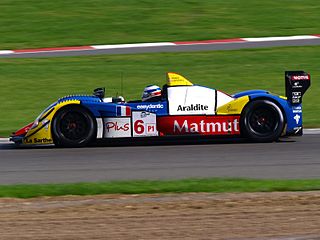
Courage Compétition was a racing team and chassis constructor company now owned by Oreca, based in Le Mans, France, near the Circuit de la Sarthe. It was founded by Yves Courage, a French race driver who ran hillclimbs before founding the company. Following the purchase of Courage by Oreca in 2007, Yves Courage has refounded the company as Courage Technology in 2010, attempting to develop electric racing cars.
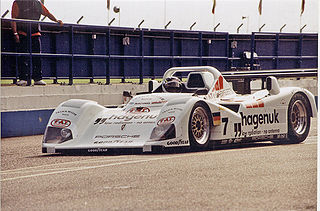
The Porsche WSC-95 was a Le Mans Prototype originally built by Tom Walkinshaw Racing. It was modified by Porsche from the original Group C Jaguar XJR-14 from which it derived, and run by Joest Racing. Originally intended to race in the IMSA World Sportscar Championship, the WSC-95 saw very little race action even though it won the 24 Hours of Le Mans in both 1996 and 1997 without being acknowledged as a factory supported project. It was later upgraded to the Porsche LMP1-98 before being retired. Only two cars were ever built.
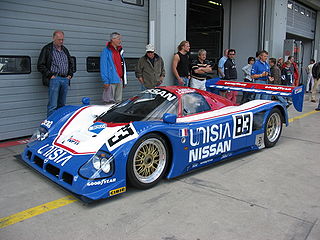
The Nissan R90C was a platform used for Group C racing cars built in 1990 by Nissan Motors for competition in World Sportscar Championship (WSC) based in Europe and the All Japan Sports Prototype Championship (JSPC). The cars based on the basic R90C platform would compete until 1993 before Nissan chose to withdraw from sports car racing, not returning until 1997. It won three JSPC championships and several significant endurance races during its career.
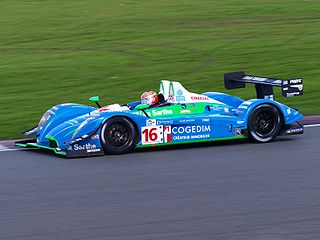
The Pescarolo 01 was the first sports prototype racing car built entirely by French team Pescarolo Sport. It had been designed to meet the LMP1 and LMP2 regulations for Le Mans Prototypes in the Le Mans Series as well as at the 24 Hours of Le Mans, and replace Pescarolo's previous C60 chassis which had been heavily modified from cars purchased through Courage Compétition. The 01s debut was at the 2007 1000 km of Monza.
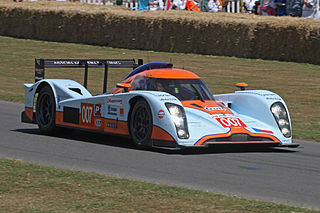
The Lola-Aston Martin B09/60, also known as the Aston Martin DBR1-2, is a Le Mans Prototype sports car built by Lola Cars International and co-developed with Prodrive for use by Aston Martin Racing. It is the first prototype to bear the Aston Martin name since the AMR1 in 1989. Aston Martin's internal name for the car, DBR1-2, refers to the specific DBR1 chassis which won six races in 1959 en route to clinching the World Sportscar Championship as well as that year's 24 Hours of Le Mans.

OAK Racing is an endurance racing team specialising in sports prototypes based in Le Mans, France. In 2013 it won the 24 Hours of Le Mans in LMP2 class and the 2013 FIA WEC World Champion drivers and teams on LMP2 class.

The Audi R18 is a Le Mans Prototype (LMP) racing car constructed by the German car manufacturer Audi AG. It is the successor to the Audi R15 TDI. Like its predecessor, the R18 uses a TDI turbocharged diesel engine but with a reduced capacity of 3.7 litres and in a V6 configuration. For the first time since the 1999 R8C, the Audi Le Mans prototype used a closed cockpit design. The R18 is also the first racing car from Audi to feature hybrid power.
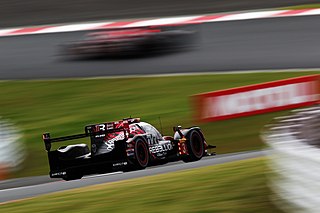
Rebellion Racing was a Swiss racing team that competed in endurance racing. The team competed in the 2011 Intercontinental Le Mans Cup season and won the LMP1 teams' title in the 2011 Le Mans Series season. The team started as an association between Speedy Racing and Sebah Racing, which began in 2008. Rebellion Racing's last team principal was Alexandre Pesci and the team manager was Bart Hayden.

Robin Donovan is a British former racing driver. He is best known for competing in 14 editions of the Le Mans 24 hours race; his best result there being 6th overall, 3rd in class (LMP1) and 1st privateer home driving with 5 x Le Mans winner Derek Bell MBE and Daytona 24 hours winner Jurgen Lassig in 1994 with the Gulf Racing entered and sponsored Kremer Porsche K8.

The Sugo Inter 500 km, was the fifth round of both the 1991 All Japan Sports Prototype Championship and the 1991 Long Distance Series, held at the Sugo on 15 September, in front of a crowd of approximately 45,000.

The Rebellion R-One is a sports prototype racing car built by French constructor Oreca on behalf of Swiss-based team Rebellion Racing. It is designed to meet the 2014 LMP1-L regulations for Le Mans Prototypes in the FIA World Endurance Championship as well as at the 24 Hours of Le Mans, and replaces the Lola B12/60 chassis. The first two R-Ones debuted at the 2014 6 Hours of Spa-Francorchamps, round two of the FIA World Endurance Championship. The Rebellion R-One shares the same monocoque as the Oreca 05, and the Oreca 07.

The CLM P1/01, renamed ENSO CLM P1/01 in 2017, is a sports prototype racing car built for Lotus Racing in 2014. The Lotus team entered the last five rounds of the World Endurance championship in 2014, but later took name as the Austrian based team ByKolles Racing. It is designed to meet the 2014 LMP1-L regulations for Le Mans Prototypes in the FIA World Endurance Championship as well as at the 24 Hours of Le Mans. The P1/01 debuted at the 2014 6 Hours of Circuit of the Americas, round four of the FIA World Endurance Championship.

The Toyota TS050 Hybrid is a sports prototype racing car developed for the 2016 Le Mans Prototype rules in the FIA World Endurance Championship. The car is the direct successor of the Toyota TS040 Hybrid, which competed in both the 2014 and 2015 FIA WEC seasons. Drivers that have tested the TS050 include Sam Bird, Thomas Laurent, Pipo Derani, Kenta Yamashita, Nyck de Vries, and Yannick Dalmas. The TS050 was revealed at the Circuit Paul Ricard on 24 March 2016 due to Toyota's two-year cycle policy. The engine is a 2.4-liter twin-turbocharged petrol V6, while the two previous cars used a naturally aspirated petrol V8. It has an 8-megajoule hybrid system, which uses lithium-ion batteries.

The Toyota R32V and R36V engine family are a series of turbocharged, 3.2-liter and 3.6-liter, 90-degree, four-stroke, V-8, gasoline racing engines, designed, developed and produced by Toyota for sports car racing; between 1988 and 1999. The engines were used in various Toyota sports prototype race cars.

The Courage C30, also known as the Courage C30LM, was a Group C2 sports prototype, designed, developed and built by French manufacturer Courage in 1993. It famously contested in the 1993 24 Hours of Le Mans, with drivers Derek Bell and Pierre Yver finishing in 10th and 11th place, respectively.




















